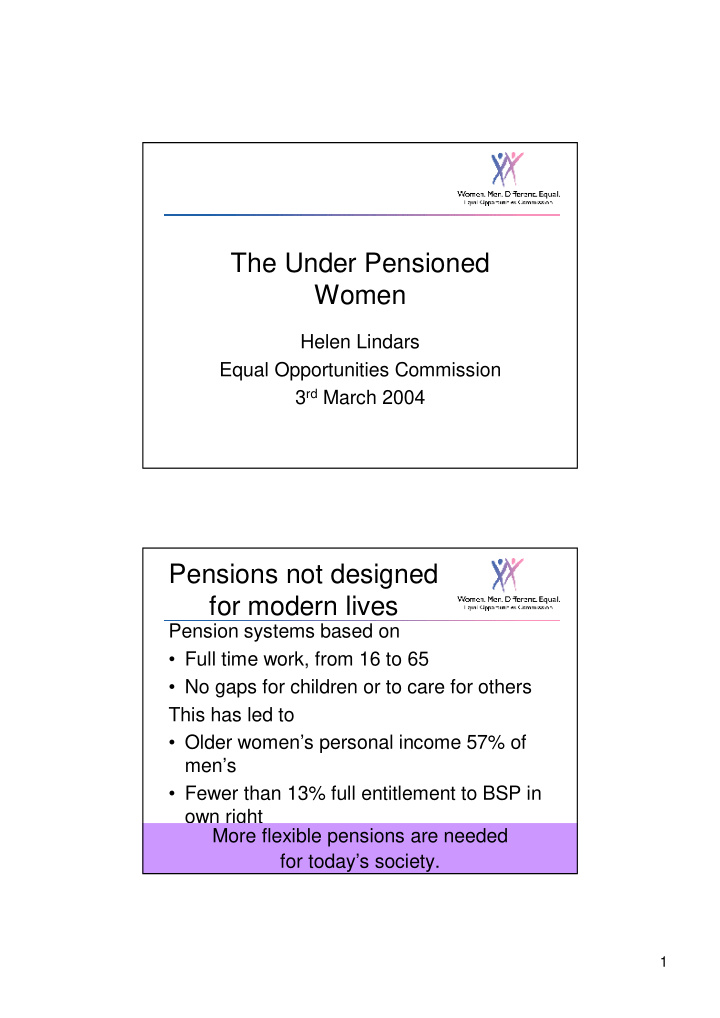



The Under Pensioned Women Helen Lindars Equal Opportunities Commission 3 rd March 2004 Pensions not designed for modern lives Pension systems based on • Full time work, from 16 to 65 • No gaps for children or to care for others This has led to • Older women’s personal income 57% of men’s • Fewer than 13% full entitlement to BSP in own right More flexible pensions are needed for today’s society. 1
Gender pay gap impacts retirement income Full time 18% Gender pay Gender gap pension gap Part time 40% Need to close the gender pay gap to close the gender pension gap. Women’s lives are significantly different to men's Absent Working Lives from paid- Parenting work Full time Caring Part time work Significantly work reduced income Significantly Retirement reduced pension income 2
Large difference between men’s and women’s working patterns • 80% of part timers are female • 60% of mothers work part time, vs. 4% of fathers. • More than ¼ of women aged 45-64 provide unpaid care for elderly or disabled people. • Almost one third of women reduce their labour market activity as a direct result of caring. Greater longevity – deeper poverty later in life. Women greater longevity than men Lower annuity Greater impact Likely to out live rates of inflation partner Have to save Dependence on Survivor benefits more to get means tested great importance. same income as benefits. men Poverty increases with age 3
Women are likely to live alone during retirement • Over 40% of women aged 65+ are widows • More than 2/3 of women aged 80 or older are widows. • 60% of women over 75 live alone. • High likelihood on reliance on survivor benefits. • Increased risk of dependence on means tested benefits Reduction in survivor benefits will have a large impact on older women Many issues with state schemes. • LEL set too high for many women. • 25% rule • Qualifying for HRP can be difficult • HRP is not a positive credit Need state pension scheme to actively reward those who have made positive but unpaid contributions to society 4
Impact of motherhood and caring on women’s pensions Proportion of Employees and the self-employed making some current private pension provision 2001/2002 Women and Men’s Women’s pension contributions pension fall consistently behind after age contributions similar 35. 74% 71% before 35 65% 62% 58% 56% 56% Men 52% 51% Women 27% 22% 20% 2% 2% 16-24 25-34 35-44 45-54 55-59 60-64 65+ Age Even those women who are able to work are less likely to contribute. Private pension provision by occupational sector Likelihood of • Women in private 20% Manufacturing occupational 8% sector - lower pension provision 13% pension coverage Construction 2% 2% • Public sector Energy and Water 1% women well Public Admin, Education and 15% Health 41% covered 16% Banking, Finance and Insurance • Fewer women in 15% Men professional and 2% Agriculture and Fishing Women 1% managerial groups. Distribution, Hotels, and 18% Restaurants 23% • More women work 5% Other services for small employers 7% All sectors should have 10% Transport 4% good pension provision 5
Women’s contributions to private pensions • Erratic contributions • Lower contributions 8% • Pensions lower 22% priority than Never 48% childcare contributed Contributed in 52% some years Contributed in every year 44% 26% Men Women Divorce – large impact on women’s pensions • One marriage in two ends in divorce • By 2021 - 840,000 divorced women over 65, and 626,000 divorced men • Low individual provision for wife during marriage – At point of divorce average pension funds for men, £46,500 and only £5,800 for women. • 300,000 divorces - 1,300 pension sharing orders • Difficult to accumulate new pension entitlement – too late to accrue interest Women need to build up pension savings in their own right throughout their lives 6
Short term changes to improve pensions Increase women’s entitlement to the basic state pension • Review LEL to include more low earners • Relax rules for HRP to include moderate amounts of caring • Abolish 25% rule, pro rata pensions for all • Add earnings from more than one job • Extend back dated contributions More radical review is required for long term success Long Term Pension Model Individual Compulsory Contributions to Second Tier Pension Credits to second tier for low earners/carers Individual entitlement to decent income in retirement Employer Government Compulsory Contributions Universal State Pension to Employees Pension 7
Recommend
More recommend